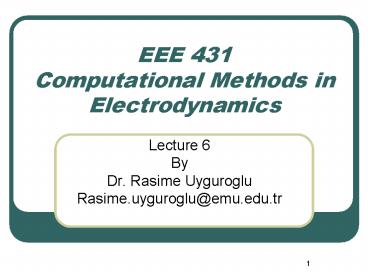EEE 431 Computational Methods in Electrodynamics - PowerPoint PPT Presentation
1 / 31
Title:
EEE 431 Computational Methods in Electrodynamics
Description:
EEE 431 Computational Methods in Electrodynamics Lecture 6 By Dr. Rasime Uyguroglu Rasime.uyguroglu_at_emu.edu.tr – PowerPoint PPT presentation
Number of Views:217
Avg rating:3.0/5.0
Title: EEE 431 Computational Methods in Electrodynamics
1
EEE 431Computational Methods in Electrodynamics
- Lecture 6
- By
- Dr. Rasime Uyguroglu
- Rasime.uyguroglu_at_emu.edu.tr
2
FINITE DIFFERENCE METHODS (cont).
3
FINITE DIFFERENCE METHODS (cont).
- Finite Differencing of Hyperbolic PDEs
- Consider the wave equation
4
FINITE DIFFERENCE METHODS (cont).
- Using central difference formula the wave
equation may be approximated as
5
FINITE DIFFERENCE METHODS (cont).
- Substituting
- Let
6
FINITE DIFFERENCE METHODS (cont).
- Example Solve the wave equation
- Subject to the boundary conditions,
- And the initial conditions
7
Finite Difference Method
- Take r1,
- For j0,
8
Finite Difference Method
- Substitute to get the starting formula
9
Finite Difference Method
- Since u1, r1, chose,
- Solve the problem for since it is
symmetric. See the C code.
10
Finite Difference Method
- Finite Differencing of Elliptic PDEs. Consider
the two dimensional Poissons Equation
11
Finite Difference Method
- Central difference approximation for the partial
derivatives
12
Finite Difference Method
- Where,
- Assume
- FD approximation of the Poissons equation after
simplification
13
Finite Difference Method
- Gives
- Or
14
Finite Difference Method
- When the source term vanishes, the Poissons
equation leads to the Laplaces equation. Thus
for the same mesh size h
15
Finite Difference Method
- The application of the finite difference method
to elliptic PDEs often leads to a large system of
algebraic equations to be solved. - Solution of such equations is a major problem.
Band matrix and iterative methods are commonly
used to solve the system of equations.
16
Finite Difference Method
- Band Matrix Method
- Notice that only nearest neighboring nodes affect
the value of at each node. - Application of the FD equations results in a set
of equation such that
17
Finite Difference Method
- Where is a sparse matrix (it has many
zeros) , is the column matrix consisting
of the unknown values, and - is the column matrix containing the known
values of . So
18
Accuracy and Stability FD Solutions
- Accuracy is the closeness of the approximate
solution to the exact solutions. - Stability is the requirement that the scheme does
not increase the magnitude of the solution with
increase in time.
19
Accuracy and Stability FD Solutions
- Unavoidable errors in numerical solution of
physical problems - modeling errors,
- truncation (or discretization) errors,
- round-off errors
20
Accuracy and Stability FD Solutions
- Modeling errors Several assumptions are made for
obtaining the mathematical model. i.e. nonlinear
system may be represented by a liner PDE.
21
Accuracy and Stability FD Solutions
- Truncation errors, arise from the fact that in
numerical analysis we can deal only with finite
number of terms of a series.
22
Accuracy and Stability FD Solutions
- Truncation errors may be reduced
- By using finer meshes. i.e. smaller time and
space step sizes and more number of points. - By using a large number of terms in the series
expansion of derivatives.
23
Accuracy and Stability FD Solutions
- Round-off Errors, are due to finite precision of
computers. - May be reduced by using double precision.
24
Accuracy and Stability FD SolutionsError as a
function of a mesh size
25
Accuracy and Stability FD Solutions
- To determine whether the FD scheme is stable,
define an error, , which occurs at time
step n, assuming a single independent variable.
Define the amplification of this error at time
step n1 as - Where is known as amplification factor.
26
Accuracy and Stability FD Solutions
- For the stability of the difference scheme it is
required that the above equation satisfies - or
27
2D Potential Distribution in a Discrete
Inhomogeneous Dielectric
- The relevant equation is
28
2D Potential Distribution in a Discrete
Inhomogeneous Dielectric
- Divide the domain into a grid.
29
2D Potential Distribution in a Disceat
Inhomogeneous Dielectric
- And
30
2D Potential Distribution in a Discrete
Inhomogeneous Dielectric
- So,
31
2D Potential Distribution in a Discreat
Inhomogeneous Dielectric
- Similarly





















![Innovative Methods Computer Assisted Instruction [ CAI ] PowerPoint PPT Presentation](https://s3.amazonaws.com/images.powershow.com/6402049.th0.jpg?_=201504091211)









